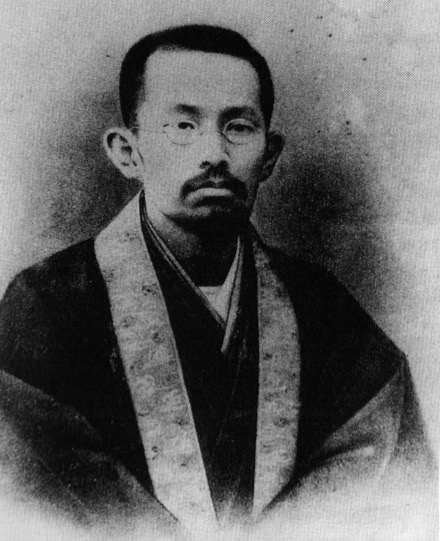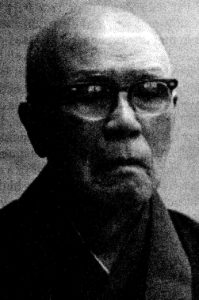
By Rev. Ken Yamada
Today, government mandates clash with personal rights; an unprecedented rise in wealth clashes with unrelenting poverty; political upheaval, military expansionism, and redefined social mores and identity abound. In these changing times, we must ask, “Is Jodo Shinshu Buddhism relevant?”
These challenges confront us now, but they also confronted a small group of innovative Buddhist thinkers a century ago, spurring them to redefine, modernize and find meaning in Jodo Shinshu, which for the previous two centuries had stagnated and grown moribund. For their contributions, they were persecuted, some even excommunicated by their own denomination. Their writings continue to be studied, debated, and valued in understanding Shinshu today.
At the forefront was Manshi Kiyozawa (1863-1903), who founded a movement called “Seishinshugi” (精神主義) (literal: spiritualism). In the book Cultivating Spirituality, A Modern Shin Buddhist Anthology, Dr. Mark Blum explained Seishinshugi as “spirituality at the forefront,” defining it as “a set of principles that prioritized personal, subjective experience as the basis for religious understanding, as well as the praxis that ideally brought about realization.”

Other major thinkers following the “Seishinshugi” banner who either studied with Kiyozawa or followed closely in his footsteps include Ryōjin Soga, Daiei Kaneko, Haya Akegarasu, and Rijin Yasuda. All hailed from the Higashi Honganji denomination. According to Blum, “it is probably not an exaggeration to say that Seishinshugi is the most important new conception of Shin thought since Rennyo reformed Honganji in the fifteenth century.”
In the book’s chapter “Shin Buddhism in the Meiji Period,” Blum’s description of the political and historical conditions giving birth to Seishinshugi struck me for its relevance to today’s social tensions, and how Shinshu needs to address pressing social problems lest it be deemed irrelevant to anyone trying to make sense of the world.
Kiyozawa lived when Japan just emerged from 200 years of isolationism, largely cut off from the outside world. Known as the Edo period (1603-1867), the Tokugawa clan ruled the country with strict measures to ensure peace and stability. Among them, Buddhist temples acted as de facto public offices, registering names, class, births and deaths of local residents, which helped the government tax and control the citizenry. Subsequently, temples performed ritual funerals and memorial services, income from which ensured their financial viability. Changes to the status quo and innovative thinking were discouraged or suppressed. Consequently, Shinshu teachings became formulaic and ritual-bound.
“Two centuries of sectarian academics had created religious conceptions that had become highly rationalized and standardized; some Shin scholars today even say that Shin doctrine had become unassailable dogma,” Blum wrote.
Japan’s long isolationism stagnated its economic development and social structure, fomenting widespread discontent. When Commodore Perry’s black ships sailed into Edo (Tokyo) Bay in 1853 demanding trade with the United States, that discontent exploded into civil war.
As a result, the Tokugawa government toppled, the old feudal order was swept away, and the dawn of a new era arose. Reformers and nativists restored Emperor Meiji as head of state. At the start of the Meiji era (1868-1912), the new administration viewed the Shinto religion as a unifying force that could promote loyalty to the emperor, Japanese values and superiority, values that aligned with the country’s new expansionist stance. Buddhism was attacked for being “non-native” and “foreign;” its institutions lost influence, income, and members. Many temples were shut down.
The country’s open door policy unleashed a flood of new viewpoints from abroad related to economics, politics, society, philosophy and religion. Buddhism seemed ill-suited to such modernization with its focus on an unworldly self, ceremony and tradition, and seemed incompatible with society’s newfound focus on nationalism, economic development and materialism.
Jodo Shinshu—with its all-encompassing Buddha and Pure Land afterlife—seemed especially anachronistic in light of Western style analysis and rational thinking. By contrast, Christianity melded easily with capitalism and claims that worldly success indicated religious salvation.
In this atmosphere of societal upheaval, Kiyozawa’s Seishinshugi movement emerged. Kiyozawa was uniquely suited to the task, having studied Western thinkers such as Kant, Hegel, Schelling, John Stuart Mill and Herbert Spencer. Discarding traditional Buddhist vocabulary and explanations, he sought to interpret Shinshu using Western terminology and thought.
The Seishinshugi movement questioned, explored and analyzed the meaning of Jodo Shinshu concepts that once were considered unassailable. What’s the meaning of faith? What role does karma play in history? What is “real” versus “symbolic?” This line of inquiry helped open debate and study within Japanese Buddhism in general.
Dr. Blum points out the Meiji period started a new chapter in Buddhist scholarship, enabling the study of Sanskrit sources and sutras. Japanese scholars during this time traveled to Europe to study with Western Sanskrit translators. The worldly and rational Buddha they encountered in Sanskrit was vastly different than the supernatural Buddhas of Mahayana sutras. Cultural references filled Sanskrit texts, calling into question the role of myth, prevalent in Indian thought.
Myth has important implications for understanding Jodo Shinshu. Before the Meiji period, such talk was considered blasphemy. Amida Buddha was a real life savior with godlike qualities whose existence was unquestionable.
Unshackled by tradition and following in Kiyozawa’s footsteps, Soga delved deep into the origins of Amida Buddha and predecessor figure Dharmakara from the perspective of myth. His analysis transcended religious dogma, plowing into the realms of the subconscious, human motivation and fulfillment, calling to mind psychoanalyst Carl Jung’s ideas on archetypes and the collective unconscious. At the time, many considered his thoughts heretical and in 1930 the Higashi Honganji denomination ousted him, although later he was reinstated.

The denomination had good reason to be defensive. Higashi Honganji, similar to other major Buddhist organizations, had long established temples, seminaries, training programs, texts and institutionalized rules. Any serious challenge to its philosophy would force a major re-formulation of the entire institution.
The role of “practice” also became problematic, especially in Jodo Shinshu, which emphasized faith over practice. The teaching of “reliance on Other Power” put at odds one’s “self-power” practice, which implied a lack of faith. Dismissing one’s “practice” became the norm.
To Kiyozawa, such teachings encouraged passive obedience to an unbending Shinshu dogma, which could not lead to true spiritual understanding. Instead, he felt the teachings were meant to guide people to their personal awakening. Kiyozawa embarked on a harsh path of ascetism, which he felt was necessary for himself, although he later abandoned it due to ill health.
Seishinshugi took a different view of Buddhism’s teaching of “Two Truths.” Originally it meant worldly or “conventional truth” versus religious or “ultimate truth.” In light of the tumultuous times, the Two Truths became a discussion of social or “political” truth versus one’s personal or “religious” truth.
This discussion was important and urgent—the government was applying increasing pressure on the populace to support its agenda of colonialism and militarism, and demanded unquestioned obedience to the emperor, which rekindled an age old question of which holds sway—the state or one’s religious beliefs. Meanwhile, Japan launched a war with China beginning in 1894, sangha members were conscripted by the military, and Jodo Shinshu priests established overseas missions, which aided colonization efforts.
Questions arose: Should the temple support the imperial edict sending young men to fight? Should chaplains go to support them? What should be the response to government policies that appear morally wrong or that harm the sangha?
Kiyozawa tackled this debate head on, arguing one’s personal spirituality came first and foremost. However, his stance put Higashi Honganji in a bind. Two and half centuries earlier, Tokugawa Ieyasu granted land, which became the denomination’s headquarters in Kyoto, and in return, Higashi Honganji became a perennial government supporter. After the Tokugawa clan toppled from power, Higashi Honganji had to make amends with the new administration. Challenging the government’s authority would not bode well. Higashi Honganji excommunicated Kiyozawa, although he was reinstated later.
These innovative Seishinshugi teachers did not think their interpretation of Shinshu was new or different. Rather, they felt this modern approach returned the teachings to their original meaning as expounded by Shakyamuni Buddha.
Seishinshugi helped modernize, not only Jodo Shinshu, but Japanese Buddhism at large, bringing new insight and relevancy to ancient teachings in modern times. The writings of teachers following this path still reverberate, bringing alive Jodo Shinshu in today’s swiftly changing world.
-Rev. Yamada is editor at Shinshu Center of America

